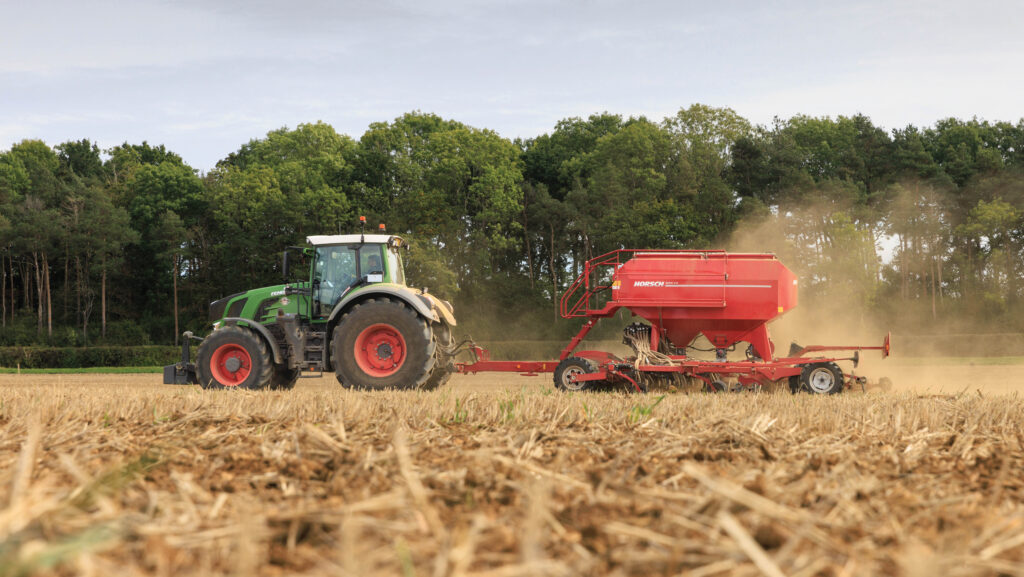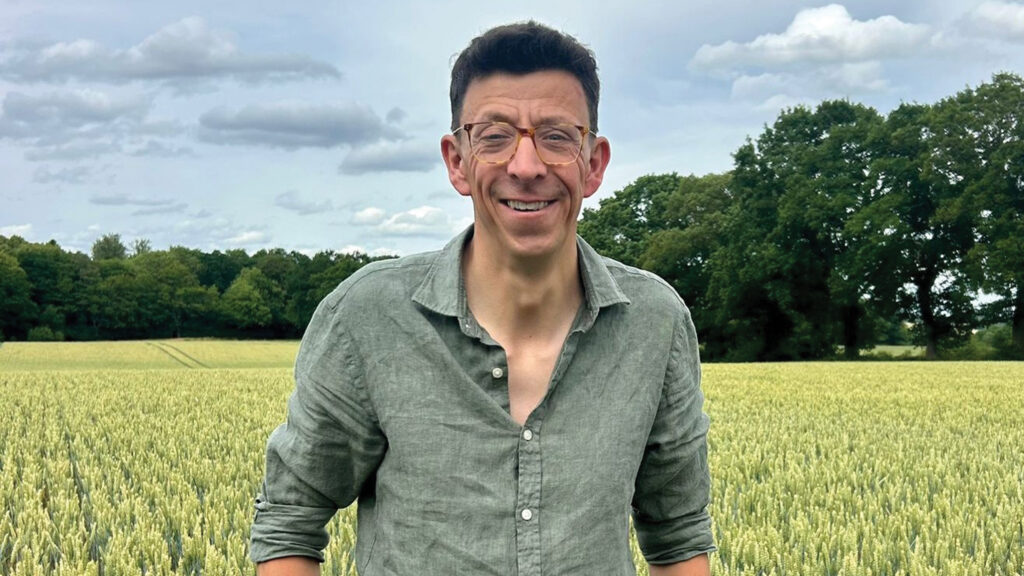Why biscuit brand is rewarding farmers for regen wheat
 © Tim Scrivener
© Tim Scrivener Payments for wheat growers moving to more sustainable farming practices are on offer from biscuit and snack maker Pladis, the owner of McVitie’s, as it expands its Back to Farm programme with a tiered rewards system.
Working with Frontier Agriculture to build a long-term, sustainable wheat supply chain, Pladis is hoping to see an increase in the 34,000t of grain from more than 4,000ha of land secured from regenerative farming systems at harvest 2025.
See also: How Cornish mixed farm gains from regen stacking
What is Back to Farm?
The Back to Farm programme started in 2010 in the north of the country to secure wheat for the manufacture of Carr’s water biscuits.
At the time, farmers were incentivised to grow a specific wheat variety that met Pladis’s quality and performance standards.
Today, the programme’s incentives are focused on sustainability, soil health and encouraging Group 3 soft wheat varieties.
Although farmers have the flexibility to choose the variety that suits their conditions providing it meets the quality criteria for biscuit production.
Longer term, Pladis is hoping to increase the volume of wheat from farms using regenerative practices and will also be exploring expansion into other crops.
While that tonnage was enough for the entire UK production of McVitie’s Original Digestives, or more than 50m packets of biscuits, Pladis has other well-known brands including Jacob’s, Carr’s and Go Ahead.
Acknowledging that future sustainability is a shared responsibility and that the way crops are grown is influencing its sourcing, the company’s ambition is to build partnerships with growers to ensure sufficient wheat supply for the entire McVitie’s range.
Tiered reward system
As a result, a tiered rewards system developed in conjunction with Frontier recognises the use of existing regenerative practices and encourages further progress at the farm level, in a performance-based model that encourages the stacking of practices.
Each farming practice is assigned a points value, reflecting its impact and alignment with Pladis’s sustainability goals.
Depending on the number of points scored, participating farmers are placed in one of three tiers: bronze, silver or gold.
Pladis three tiers
- Bronze – entry-level recognition for farmers meeting foundational criteria
- Silver – for those adopting more advanced practices and demonstrating measurable improvements
- Gold – the highest level, awarded to farmers who are leaders in sustainable innovation and performance
As Pladis explains, each tier is associated with a payment, scaled to reflect the level of commitment.
The tiered structure has been designed to give farmers the confidence to make progress as well as the flexibility to do what makes business sense.
“We know that growers are looking at regenerative farming, but we recognise that it’s a big ask for them to change their practices without additional support,” says Jennifer Parise, director of procurement and sustainability at Pladis UK & Ireland.
“Given on-going reductions in government funding and resulting financial uncertainty, this scheme will help them address the challenges faced, shoulder some of the risk involved in change and deliver beneficial environmental outcomes.”
Sustainable supply chains
Jim Knightbraid, sustainability manager at Frontier Agriculture, explains that helping farmers to produce crops profitably, while taking care of the farmed environment, is key to sustainable supply chains.
“Private sector schemes have a big part to play, so we are delighted to be working with Pladis to expand its Back to Farm programme and help growers implement more sustainable and regenerative practices, where appropriate.
“Not only will we be providing technical support through our crop production team, we will also be tracking and reporting on the positive outcomes achieved, as well as rewarding farmers for doing their bit.”
Frontier currently has eight different supply chain programmes running, with average payments of £70-£80/ha, he reports.
“Where you have a wide range of sustainable actions on offer, the payment varies with their uptake. Individual farm circumstances will dictate what’s possible, which is why there is a broad choice of actions within the Pladis programme.”
For the farmers that Frontier works with, these schemes help to de-risk crop production, improve the resilience of farming systems and safeguard profitability, he adds.
“Support for farmers to move to more regenerative practices from businesses like Pladis is very welcome.”
Farm practices in the Back to Farm programme |
||
|
Field specific |
Points |
|
|
Rotation |
Three crops in rotation |
3 |
|
Four crops in rotation |
4 |
|
|
Five or more crops in rotation |
5 |
|
|
Overwinter stubble following harvest |
1 |
|
|
Legume break crop in previous season |
2 |
|
|
Legume fallow in previous season |
3 |
|
|
Cover crop following harvest |
4 |
|
|
Catch crop ahead of establishment |
4 |
|
|
Nutrition |
Soil organic matter measurement |
1 |
|
Use of legume companion crop |
1 |
|
|
Soil grid sampling pH/P/K/Mg |
2 |
|
|
Straw chopped and incorporated |
2 |
|
|
Use of variable-rate nitrogen |
2 |
|
|
Use of biostimulants to improve nitrogen use efficiency |
3 |
|
|
Use of low carbon fertiliser |
3 |
|
|
Use of nitrification inhibitors |
4 |
|
|
Use of organo-mineral fertiliser |
5 |
|
|
Crop Insight |
Field grain analysis |
1 |
|
Crop carbon footprint |
1 |
|
|
Tillage |
Points |
|
|
Plough |
0 |
|
|
Reduced till/min till |
4 |
|
|
No-till |
8 |
|
|
Whole farm |
Points |
|
|
Integrated pest management plan |
1 |
|
|
Soil management plan |
1 |
|
|
Nutrient management plan |
1 |
|
|
Farmland habitat 3% of farmed area |
3 |
|
|
Farmland habitat 5% of farmed area |
4 |
|
|
Farmland habitat 7%+ of farmed area |
5 |
|
Case study: Will Waterer, Waterers Farms, Essex
The attraction of another income stream without a long-term commitment attached to it persuaded north Essex grower Will Waterer to sign up to the Pladis/Frontier scheme for harvest 2025.

Will Waterer © Frontier
Like many farmers, Will had been moving to more sustainable farming methods and incorporating stewardship into the rotation for a while, so he was well-placed to put some of his Group 3 winter wheat Bamford into the Back to Farm programme.
As a result, he qualified for the silver tier, which will see him receive £80/ha when the wheat is sold.
“Payment is conditional on it achieving the quality specifications set out in the contract, but that wasn’t a problem despite the dry conditions.”
Will notes that he would only have to make a couple of tweaks to qualify for the gold tier, which brings a higher payment.
“The programme does give us the confidence and offers enough flexibility to try other ways of doing things, but any changes we make have to work for the whole business.”
After some initial system hiccups, supplying the data needed was made easier by his use of Omnia software.
“I also liked the fact it was only a one-year contract, so I didn’t feel tied in beyond the year.”
He makes the point that support from the supply chain is crucial as weather volatility continues to impact harvests and government funding is rapidly disappearing.
“If we’re not going to receive public money, then we have to look at these opportunities.”
Will is growing Bamford, which he plans to enter into the programme for harvest 2026 when it opens for enrolment later this year.

